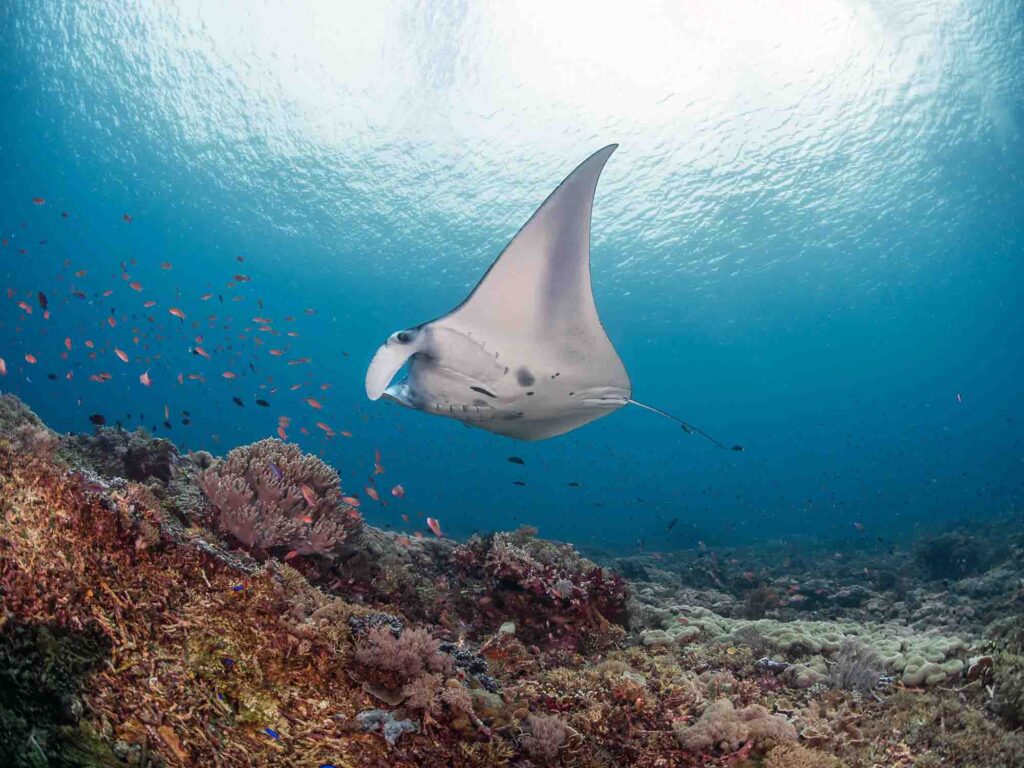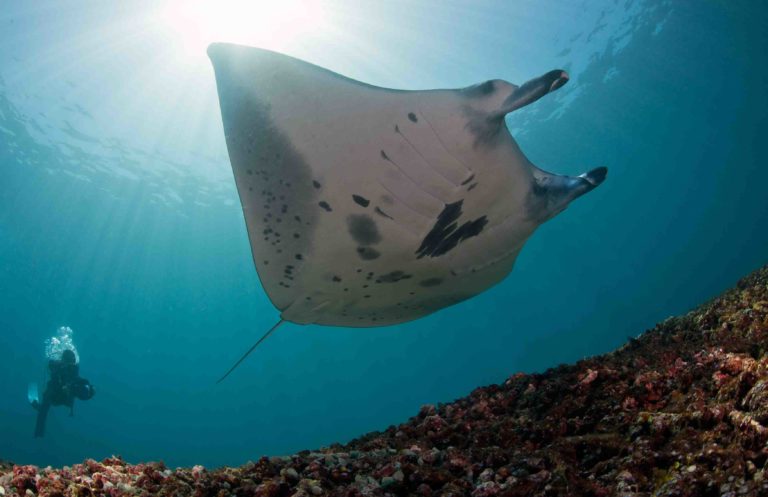Manta rays choose to stick around Indonesia’s Komodo National Park in unusually large numbers – and, according to a new diver-led study, this community could be the key to regional recovery of the threatened species.
A total of 1,085 individual reef mantas (Mobula alfredi) have been identified at the UNESCO World Heritage Site thanks to the efforts of local and visiting scuba divers working with scientists from the Marine Megafauna Foundation (MMF) charity and Murdoch University in Western Australia.
Reef mantas up to 5m across live, feed, mate and visit cleaning stations in shallow coastal habitats in the national park, says the MMF. Photographs of individuals were submitted to the crowdsourced online database MantaMatcher.org, with the majority taken at four of the 20 locations most visited by tourist boats.
“I was amazed by how receptive the local dive community was in helping to collect much-needed data on these threatened animals,” said lead author Dr Elitza Germanov. “With their support, we were able to identify over 1,000 individual manta rays from over 4,000 photographs.” Mantas can be distinguished by their unique ventral coloration patterns.
“People love manta rays – they are one of the most iconic animals in our oceans,” said MMF co-founder and study co-author Dr Andrea Marshall. “The rise in the number of people engaging in scuba diving, snorkelling and the advent of affordable underwater cameras meant that photos and videos taken by the public during their holidays could be used to quickly and affordably scale data-collection.”
Using the time and location data attached to the photos, sighting histories of individual mantas were analysed and models created to predict the likelihood of rays inhabiting or travelling between specific sites.


Some rays would swim as far as the Nusa Penida marine protected area (MPA) 450km to the west while others kept moving around the park, but most mantas preferred to inhabit specific sites within it.
“I found it very interesting how some manta rays appear to prefer spending their time in some sites more than others, even when sites are 5km apart, which are short distances for manta rays,” said Dr Germanov. This could however adversely affect rays that preferred sites where fishing or more tourist-boat activities occurred.
Fishing has been prohibited in many of the park’s coastal areas since 1984, with mantas declared protected in Indonesia since 2014, but illegal fishing remains a threat. The study found that some 5% of Komodo’s mantas bore permanent injuries likely to have been caused by fishing gear.
Over the course of the five-year study, conducted from 2013-18, the popularity of the tourist sites increased by more than a third. In 2019 the Komodo National Park Authority acted to limit the number of boats and people visiting one particularly popular site.

“This study shows that the places where tourists commonly observe manta rays are important for the animals to feed, clean and mate,” commented Ande Kefi, a park employee involved with the study. “This means that the Komodo National Park should create measures to limit the disturbance at these sites.
“I hope that this study will encourage tourism operators to understand the need for the regulations already imposed, and increase compliance.”
MPAs big enough to host important manta ray habitats are beneficial to their conservation, say the authors of the study, just published in PeerJ. However, they recommend that codes of conduct for diving and snorkelling with mantas should be made mandatory, and that the number of tourist boats allowed at aggregation sites at any one time should be limited.
New Indian Ocean eagle ray
A new species of eagle ray has been identified, according to the Abu Dhabi Environment Authority. Analysis of samples collected during a 2016 survey to assess fish stocks in the Arabian Gulf revealed the species, which had initially been confused with the similar banded eagle ray (Aetomylaeus nichofii).
Dubbed Wafc’s eagle ray, Aetomylaeus wafickii is distinguished from similar species by having more pale blue to light grey bands across its back (8-10), more tooth-plate rows (13-15), a narrower upper tooth-plate and a shorter tail. Males generally have fewer pelvic-fin rays (14-16) than females (16-19).
Wafc’s eagle ray is found from the southern Red Sea across the northern Indian Ocean to Sri Lanka. Because it tends to school, it is considered particularly susceptible to being caught in gillnets. It has now been described in the journal Marine Biodiversity.
Also on Divernet: Mystery Rays Under Investigation

